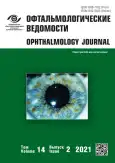The features of diagnosis and treatment of unilateral concomitant strabismus with visual fixation defect in preschool children
- Authors: Kononova N.E.1, Somov E.E.1,2
-
Affiliations:
- St. Petersburg State Pediatric Medical University
- S.N. Fedorov National Medical Research Center “MNTK “Eye Microsurgery”
- Issue: Vol 14, No 2 (2021)
- Pages: 47-54
- Section: Original study articles
- URL: https://journals.rcsi.science/ov/article/view/63501
- DOI: https://doi.org/10.17816/OV63501
- ID: 63501
Cite item
Abstract
BACKGROUND: Particular difficulties in treatment of children with monolateral strabismus are associated with the presence of severe amblyopia in the squinting eye in combination with a visual fixation defect (acentral or intermittent).
AIM: To assess the anatomical and functional status of children with visual fixation defects, to find out the causes of failures in treatment of this group of patients, to determine the tactics of their management.
MATERIALS AND METHODS: The study included 92 children of preschool age (from 3 to 7 years) with monolateral concomitant strabismus. The follow-up period for the children ranged from 12 to 72 months. The average age of the examined children was 4.6 ± 1.1 years. Three variants of visual fixation were identified in the squinting eye: central visual fixation (CVF) – 68 eyes; intermittent visual fixation (IVF ) – 7 eyes; and acentral visual fixation (AVF) – 17 eyes. All patients underwent a comprehensive examination: visometry; strabometry; autorefractometry; determination of the critical frequency of light flashes; assessment of visual fixation; optical coherence tomography of the retina. All children underwent “passive” and active pleoptics.
RESULTS: The visual acuity of children with CVF significantly increased due to pleoptics. At the same time in cases of IVF and even more in those of AVF, visual acuity remained significantly lower than that of the “fixating” eye, pleoptics were ineffective in this group of patients. In patients with CVF, the critical frequency of light flashes of the squinting eye increased in statistically significant figures, while in IVF and AVF, the difference between squinting and fixing eye remained. According to OCT data, changes in the macular area were detected in 18 (75%) eyes in patients with IVF and AVF, which allows us to distinguish organic pathology from amblyopia.
CONCLUSIONS: In children with monolateral strabismus, it is necessary to determine visual fixation of the squinting eye. At IVF and AVF, it is mandatory to conduct optical coherence tomography of the macular area to exclude organic pathology. In patients with monolateral concomitant strabismus with IVF and AVF, surgery on oculomotor muscles is indicated.
Full Text
##article.viewOnOriginalSite##About the authors
Nadezhda E. Kononova
St. Petersburg State Pediatric Medical University
Author for correspondence.
Email: Nali-6@yandex.ru
ORCID iD: 0000-0002-2145-1762
SPIN-code: 7217-3582
ophthalmologist
Russian Federation, 2 Litovskaya str., Saint Petersburg, 194100Evgenij E. Somov
St. Petersburg State Pediatric Medical University; S.N. Fedorov National Medical Research Center “MNTK “Eye Microsurgery”
Email: nali-6@yandex.ru
ORCID iD: 0000-0001-8999-6614
SPIN-code: 6403-6911
Dr. Sci. (Med.)
Russian Federation, 2 Litovskaya str., Saint Petersburg, 194100; Saint PetersburgReferences
- Markova EYu. Modern tendencies in the treatment of strabismus in children. Ophthalmology. 2016;13(4):260–264. (In Russ.) doi: 10.18008/1816-5095-2016-4-260-264
- Nelson BA, Gunton KB, Lasker JN, et al. The psychosocial aspects of strabismus in teenagers and adults and the impact of surgical correction. J AAPOS. 2008;(12):72–76. doi: 10.1016/j.jaapos.2007.08.006
- Mojon-Azzi SM, Kunz A, Mojon DS. Strabismus and discrimination in children: are children with strabismus invited to fewer birthday parties? Br J Ophthalmol. 2011;95(4):473–476. doi: 10.1136/bjo.2010.185793
- Wen G, McKeanCowdin R, Varma R, et al. General healthrelated quality of life in preschool children with strabismus or amblyopia. Ophthalmology. 2011;118(3):574–580. doi: 10.1016/j.ophtha.2010.06.039
- Ziaei H, Katibeh M, Mohammadi S, et al. The impact of congenital strabismus surgery on quality of life in children. J Ophthalmic Vis Res. 2016;11(2):188–192. doi: 10.4103/2008-322X.183918
- Shahraz S. Quality of life and strabismus surgery in children. J Ophthalmic Vis Res. 2016;11(2):129–130. doi: 10.4103/2008-322X.183931
- Kashhenko MA, Kashhenko TP, Pedanova EK, Magaramova M.D. Sposob formirovanija central’noj zritel’noj fiksacii u detej i vzroslyh s ambliopiej s necentral’noj fiksaciej. Russian Ophthalmology Online. 2019;(34). (In Russ.) Available from: https://eyepress.ru/article.aspx?41147
- Kashhenko TP, Rajgorodskij JuM, Kornjushina TA. Funkcional’noe lechenie pri kosoglazii, ambliopii, narushenijah akkomodacii. Metody i pribory. Moscow: IIC SGMU; 2016. 163 p. (In Russ.)
- Plisov IL. Ambliopija: Metody diagnostiki i lechenija. Prakticheskie sovety. The world of ophthalmology. 2011;(2):4. (In Russ.)
- Avetisov ES. Disbinokulyarnaya ambliopiya i ee lechenie. Moscow: Meditsina; 1968. 206 p. (In Russ.)
- Rozhkova GI, Lozinskij IT, Gracheva MA, et al. Functional correction of impaired binocular vision: benefits of using novel computer-aided systems. Sensornye Sistemy. 2015;29(2):99–121. (In Russ.)
- Neroev VV, Maglakelidze NM, Zueva MV. Pathophysiology of amblyopia: is the retina involved? Russian Ophthalmological Journal. 2014;7(4):98–105. (In Russ.)
- Andalib D, Javadzadeh A, Nabai R, et al. Macular and retinal nerve fiber layer thickness in unilateral anisometropic or strabismic amblyopia. J Pediatr Ophthalmol Strabismus. 2013;50(4):218–221. doi: 10.3928/01913913-20130319-02
- Araki S, Miki A, Goto K, et al. Macular retinal and choroidal thickness in unilateral amblyopia using swept-source optical coherence tomography. BMC Ophthalmol. 2017;17(1):167. doi: 10.1186/s12886-017-0559-3
- Chen W, Chen Huang J, Xu J, et al. Comparison of macular and retinal nerve fiber layer thickness in untreated and treated binocular amblyopia. Curr Eye Res. 2013;38(12):1248–1254. doi: 10.3109/02713683.2013.805233
- Dickmann A, Petroni S, Perrotta V, et al. Measurement of retinal nerve fiber layer thickness, macular thickness, and foveal volume in amblyopic eyes using spectral-domain optical coherence tomography. J AAPOS. 2012;16(1):86–88. doi: 10.1016/j.jaapos.2011.09.011
- Wu SQ, Zhu LW, Xu QB, et al. Macular and peripapillary retinal nerve fiber layer thickness in children with hyperopic anisometropic amblyopia // Int J Ophthalmol. 2013;6(1):85–89. doi: 10.3980/j.issn.2222-3959.2013.01.18
- Xu J, Lu F, Liu W, et al. Retinal nerve fibred layer thickness and macular thickness in patients with esotropic amblyopia. Clin Exp Optom. 2013;96(3):267–271. doi: 10.1111/cxo.12001
Supplementary files










